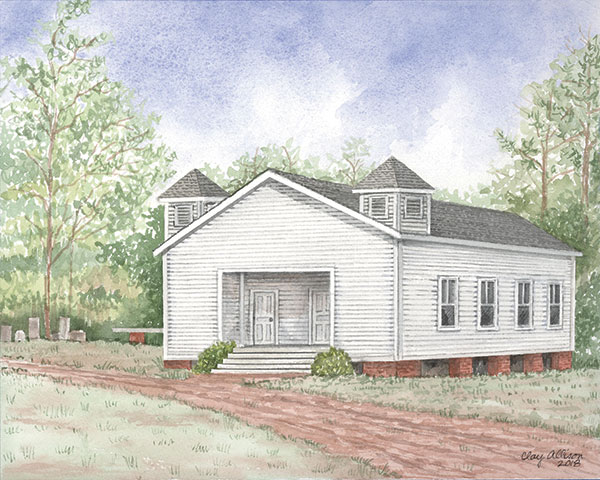
Two churches, a single purpose
Story by Joe Whitten
Photos by Michael Callahan
Submitted photos
Mt. Zion Baptist Church, a church started by freed slaves in Springville, exists today because in 1816 a North Carolina minister grew discouraged in the ministry and resolved to abandon preaching. Leaving preaching and North Carolina behind, Rev. Sion Blythe moved his family to what would become St. Clair County, Alabama, and settled along Canoe Creek.
Published writings referred to Blythe as “the reluctant preacher.” Born in Tennessee in 1781 and ordained as a minister in North Carolina, Blythe organized and pastored churches in Buncombe County, North Carolina.
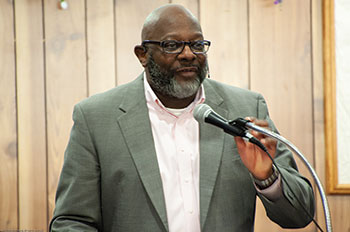 When Blythe and family left North Carolina and headed west, he instructed his wife to tell no one that he had preached. No written record states exactly why he had become so disheartened; however, his friend and Alabama Baptist historian, Hossa Holcombe, hinted that the problem was a theological difference with North Carolina pastors concerning man’s free will.
When Blythe and family left North Carolina and headed west, he instructed his wife to tell no one that he had preached. No written record states exactly why he had become so disheartened; however, his friend and Alabama Baptist historian, Hossa Holcombe, hinted that the problem was a theological difference with North Carolina pastors concerning man’s free will.
But Pastor Blythe’s free will choice to stop preaching was over-willed by his integrity when in late 1816 or early 1817, a woman in the area where he had settled asked him point blank if he were not a minister of the Gospel.
Blythe wouldn’t lie to her, and when he admitted that he had preached, Holcomb records, “The old lady leaped, and shouted, and praised God that she had found a preacher in the wilderness.” At her urging, Blythe agreed to organize a congregation, and on March 22, 1817, in the settlement called Big Springs, a Baptist church was established and named Mt. Zion. The name referencing verse in Hebrews 12:22, “Ye are come into Mount Zion and unto the city of the living God, the heavenly Jerusalem …” and reminding them of their goal, Heaven, the city of God.
Until the end of the Civil War, both slave and master worshiped together — but separate — at Mt. Zion, for as Margaret Windham records in her History of Springville the “…slaves had seats in the rear of the church building and, like their masters, were members of the church.”
One wonders about the names of those slave members, but we have scant information. The oldest minutes of Mt. Zion fell victim to fire when the home where they were kept burned. Because Martha Terry Roberts had copied portions of the old minutes that mention slave names, we have some, as quoted here:
- April Term, 1821—Received Brother James, a black man, by letter.
- May Term, 1823—Received by experience, Littie, a black woman, and Lisha More and also Pike.
- August Term, 1823—Received by experience, Sook, a black woman.
- June Term, 1831—A charge against Fanny, a black sister, for having two living husbands. Case taken up and Fanny restored to her seat as usual.
- October, 1844—Sister Jane, Nancy, Elizabeth, and Margaret (blacks) dismissed by letter.
- September, 1854—James Thomason called for a letter of dismissal, and for four of his blacks: Alfred, Clark, Doctor, and Reny. Granted.
Sister Fanny’s case in June, 1831, is of special interest. This writer became acquainted with slave wedding vows several years ago when touring Rose Hill Mansion near Hilton Head, South Carolina. The guide, a descendant of the builder of Rose Hill, told that slave wedding vows had these words, “Till death or distance do us part”—meaning that if one partner in the marriage were sold, the wedding vows were dissolved. Ordained ministers rarely performed slave weddings, which were never legally binding, and he couldn’t have them say “Till death do us part,” due to their circumstances.
Usually a slave couple wanting to marry might have a ceremony in the slave quarters, but most often, the couple would simply “Jump over the broom,” and they were married. An online article published by the Caswell County, North Carolina, Historical Society discusses the jumping over the broom and also white ministers’ use of “Till death or distance do us part” in Antebellum slave weddings.
The fact that in the same June meeting Fanny was restored to her seat in the church fellowship makes this writer believe that this was Sister Fanny’s reason for having two living husbands and the church sympathized with her.
The expression “received by experience” means the candidate for membership had recently come to an experience of salvation. To be dismissed by letter means to be dismissed in good standing to another church.
From those minutes we learn the first names of several slaves and the name of one of the slave owners, James Thomason. Although it is meager, these nuggets of information can assist slave descendants in genealogical research.
Changing times
In time, some stout-hearted people of the United States began to take note of the injustice of slavery, and a distant rumble began to arise, like far-away thunder forewarning an approaching storm. The rumble grew until in 1861, it roared into a storm of civil war, which by 1865 had wreaked ruin on much of the nation and unshackled slaves and set them free.
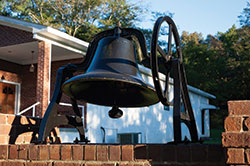 But being declared free and grasping the reality of freedom are two concepts not comprehended quickly. Former slaves, now free to congregate and worship together, continued to meet with Mt. Zion until 1868.
But being declared free and grasping the reality of freedom are two concepts not comprehended quickly. Former slaves, now free to congregate and worship together, continued to meet with Mt. Zion until 1868.
According to oral history, in 1868 the freed slaves of Springville began meeting on their own to worship God. No written record seems to exist for this group of believers prior to 1883, the year they joined Wills Creek Baptist Association in Etowah County.
For white Mt. Zion, the war years took its toll on church membership through battlefield casualties and through the emancipation of slaves. Mrs. Windom records that by 1870 the membership of Mt. Zion had dwindled to 70. That congregation decided to construct a more modern sanctuary that might encourage more people to worship with them. They began meeting in the new building in 1871. In that same year, Mt. Zion changed its name to Springville Baptist. With a new building, it probably seemed to them a good idea to identify the church with Springville.
Oral history doesn’t record just when the freed slaves began calling their group Mt. Zion. However, in their History of Springville, Alabama, Donna Cole and Virginia Taylor wrote, “After the war, the Black congregation left to form their own church and they kept the original Mt. Zion name.” It’s possible that two Mt. Zion Baptist Churches existed for a while in Springville.
The name became official in 1883. The Tenth Annual Session of the Wills Creek Baptist Association met at the Ashville Mt. Zion Church in August 1883, and the minutes record: “Received Mt. Zion Baptist Church of Springville, on the AGSRR [Alabama Great Southern Rail Road], as a newly constituted church — delegates, Elder L.C. Thornton, R. Pruet. Sent for missions, 50 cents; minutes, $1.00.”
Other Wills Creek Association minutes give more Mt. Zion facts:
- 1888, meeting at the Cedar Bluff , R.H. Vogal, Pastor; Emma Galbreth, Clerk; and 71 members.
- 1892, meeting at Mt. Zion, Ashville, J.H. Kerley, Pastor; J.H. Hudson, Clerk.
- 1896, meeting at Lebanon Baptist, C.C. Curry, Pastor; F. Thaxton, Clerk, and 45 members.
- 1897, meeting at Mt. Zion, Springville, C.C. Curry, Pastor; L. Byers, Clerk; 53 members.
Building a church
The first church building was constructed on the same property where the Mt. Zion church stands today. We don’t know the date of that construction, but the minutes of 1896 report the value of Mt. Zion’s church property as $1,000. That value in 1896 probably included a building.
Deacon Mitchell Hammonds recalled the church building, for he attended there as he grew up. “The church, when I was born, was a wooden building. It had two bell towers. It had a bell in one. It had two front doors and had three rows of pews. That old building had, of course, the big pot-belly heater.” That church was taken down and replaced with the present structure around 1976.
On sun-lit days, light streaming through the “Life of Christ” stained-glass windows bejewels the sanctuary. The vintage stained-glass cross window gracing the front of the church was donated to Mt. Zion by First Baptist Church of Springville.
Estell Long, who was born in 1936 and grew up in the church, fondly remembers the bell ringing. “You had a rope up there. … Will Woods would go early Sunday morning and pull the rope and the bell would tone.”
She recalled that during revivals the seats at the front of the church were reserved for those who wanted to be baptized and join the church. At the end of the week, the church would have a baptism at Lee Laster’s Creek. Mitchell Hammonds recalled that he was baptized in the Cahaba in Trussville. Later, the church was able to build an outside baptistry on site.
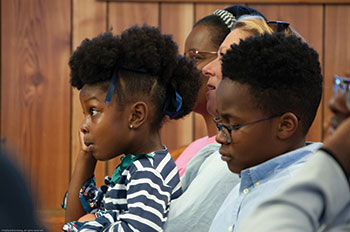 Mrs. Long reminisced about the singing in the church. “They had people in the choir, and they sang the old-fashioned songs. Mattie Kelly was the pianist. She would play the piano, and they would sing. When she finished, she would always shout. She was one of the shouting sisters in church.” Another pianist was Mattie Jo Williams Herring.
Mrs. Long reminisced about the singing in the church. “They had people in the choir, and they sang the old-fashioned songs. Mattie Kelly was the pianist. She would play the piano, and they would sing. When she finished, she would always shout. She was one of the shouting sisters in church.” Another pianist was Mattie Jo Williams Herring.
Some of the choir members Mrs. Long remembered are Sarah Frances Newsome, Velma Eleanor Newsome, Casey Lewis, Elizabeth Shepherd, Ruth Pulliam, Katherine Newsome, Margaret Hammonds Woods, Leola Pulliam Herring, Josephine Pulliam Herring and Nellie Mae Newsome Boyd.
Nellie Mae Newsome Boyd also served as a missionary to other churches in the surrounding area — Attalla, Ashville and Branchville. She would take reports from church to church so they could know the work of sister churches in the region. On these visits, she could share needs from the churches in her circle of ministry.
The young people of the church weren’t neglected. In the 1940s and 50s, Mary Bradford instructed the youths of Mt. Zion in the Baptist Young People’s Union – BYPU. Part of her teaching was having them memorize different Scripture passages, such as the Twenty-third Psalm. She assigned the passage at one meeting, and at the next meeting she expected each one to quote the passage from memory. Miss Bradford made sure each had memorized the Scripture.
Harvey Lovell Newsome served as Sunday School Superintendent in the 1940s and 1950s, and after Mr. Newsome, Sammy Kelly served as Superintendent.
Mrs. Long and Mr. Hammonds recalled the following men who served Mt. Zion as deacons: Sammy Kelly, Henry Beaman, Brook Toles, Bob Woody, Milton Herring and Willie LaShore.
Present day Mt. Zion
At present, active deacons are Mitchell Hammond, Henry Wright and Willie Jones Sr. These deacons minister to the church and community. One way is the Brotherhood Breakfast that meets on the first Saturday of each month. This interracial meeting begins with fellowship and breakfast. Henry Wright is credited with organizing this monthly event, with the purpose of encouraging each other in Christian faith, the preferred devotional topic for each speaker is “Why are you a Christian and what is in it for you?”
Yearly events at Mt. Zion include the National Day of Prayer, summer revivals and Youth Month in June, which includes a youth revival. Each February, the young people learn of African-American history on Wednesday nights. A favorite summer event has been the church trip to Lake Winnepesaukah in Chattanooga for a day of fun and relaxation.
Pastoring Mt. Zion
Mt. Zion has an incomplete list of former pastors. A careful research of the Wills Creek Baptist Association’s minutes could perhaps furnish a complete listing. Nineteenth Century pastors include L.C. Thornton, 1883; R.H. Vogal, 1888; J.H. Kerley, 1892; and G.W. Burton, 1896-1897. The church also has names of 15 pastors since 1901. Pastors since1937 include W.R. Simpson; T.C. Williams; I.H. Henderson; Joseph Jackson; and currently, Larry Adams.
Adams has pastored Mt. Zion since 2011. During his seven years shepherding the flock, he has seen spiritual growth in his congregation. His preaching emphasis is the whole Word of God, preaching it in context. He recently said, “We don’t skip anything. Even in our Bible study, we go verse by verse.” Pastor Adams, a bi-vocational pastor, is sometimes out for a Wednesday evening Bible study. Therefore, he makes sure he and the one teaching for him are together. “Right now,” he said, “we’re studying the book of Hebrews on Wednesday night. And if some of my other ministers are doing the teaching, I give them an outline of what we’re teaching, and we follow that outline. We have everybody together. They ask questions, and I get excited about teaching the Bible. And I say, ‘We’re gonna teach the whole Bible,’ and I have.”
Pastor Adams gets enthusiastic telling about the church and its ministries. The Children’s Church involves a wide range of ages — first-grade through 12th. The older group mentors the younger ones as a part of the Youth Ministry.
The church’s music ministry consists of Men’s Choir, Women’s Choir and Youth Choir. The Mass Choir combines the Men’s Choir and the Women’s Choir together for a service. The organ, keyboard and drums accompany the singing.
History within history
A current need for the church is a larger building with classrooms and a fellowship hall. The congregation has discussed this need and is working toward the goal. One discussion point is whether to build where the church now stands or to build on the church-owned lot diagonally across the street from the present structure.
Mt. Zion purchased the 1920s-era Springville Colored Elementary School building from the St. Clair County Board of Education after integration closed the school. They have renovated the building located next to the church and use it as their fellowship hall.
Springville Colored Elementary School was a two-room, two-teacher school with grades one, two and three in one room, and grades four, five and six in the other. Mrs. Long remembered her teachers in the 1940s as being Miss Mary Reid the first three years, and Zora Quinn the last three years. Mr. Hammonds recalled names of other teachers: Pauline Hudson, Alberta Williams, Sarah McCray and Rosey Dial (Pauline Hudson’s sister).
Students desiring high school education had to go to the Ashville Colored High School, which was later named Reuben Yancey High School. By the time Mrs. Long was in the seventh-grade, a bus transported students from Springville to Ashville. However, they were required to meet the bus at a store located near today’s Dollar General. The students living in the Flat Woods, or Jones Village, had to walk up to Highway 11 to meet the bus.
Before the St. Clair County Board of Education provided transportation, the only African-American students who attended high school were those who could afford to ride the Greyhound Bus to and from Ashville. Mrs. Long said Claudie C. Woody and William Hammonds were the only two students who earned high school diplomas before transportaton was provided free to students.
Mr. Hammonds recalls fondly his teachers and their instruction at Springville Colored Elementary School. “Our teachers always encouraged us to be the best that we could. They encouraged us to reach high and to hold high standards.” He quietly reflected a moment on integration, then, added that in the old school, the teachers “… tried to instill values in us. You know, be the best that you could be. They wouldn’t accept less.”
So, the old 1920s school building serves an interracial church — a church outgrowing its current facilities and looking to the future.
Pastor Adams is excited that Mt. Zion Baptist Church and First Baptist Church are doing things together. Pastor Chipley McQueen Thornton and Pastor Larry Adams became friends early on and have worked together in the community. The two churches have a combined service and fellowship meal once a year at First Baptist. This year, an additional Thanksgiving combined service is planned for November 25, with lunch to follow. Both congregations look forward to these joint services.
The two pastors are together on missions. Pastor Thornton has twice taught theology to local pastors in Africa. In February 2019, the African pastors will meet in Paris, France, and Thornton has asked Pastor Adams to go with him to do some of the teaching. Pastor Adams recently said, “Pastor Chip asked me, ‘You got your passport?’ And I said, ‘I got it! I’m ready!’ He and I are going over what we’re going to teach to be sure we’re on the same page. Chip is a tremendous teacher.”
When asked for a comment about Pastor Adams, Pastor Thornton replied, “I shook his hand and sensed I was in the presence of a genuinely spiritual man, a man of God. He carries that aura. After hearing him so eloquently expound the Scripture, I thought, ‘Ah! Here is another Apollos (Acts 18:24)! We must go train others to do the same.’ I eagerly invited him to go with me to teach pastors. He eagerly accepted, praise the Son! Now off to Paris we go, trusting in the good will of God to guide us, come what may.”
Reaping rewards
The work that Sion Blythe began in Big Springs, Alabama, in 1817, flourishes today in two churches. Blythe never dreamed that the one church would become two when slaves gained freedom. But in God’s timing, a church of freed slaves formed, and today both First Baptist Church Springville and Mt. Zion trace their history to March 22, 1817.
Pastor Adams’ purpose for being a minister is to let people “know that God loves them and that Christ died for them.” And for his congregation, he desires they grow in understanding God’s Word as he shepherds them toward Zion, the City of God.
Folks familiar with long-ago church songs can hardly think of the name Mt. Zion without thinking of lines from Isaac Watts’ 1707 hymn:
We’re marching to Zion,
Beautiful, beautiful Zion,
We’re marching upward to Zion,
The beautiful City of God.
And if we listen closely, we may hear Sister Mattie Kelly’s shouts of “Glory! Hallelujah!” still echoing down the years.
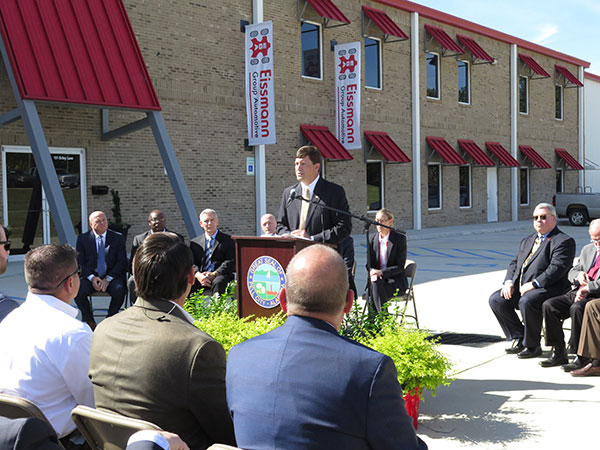
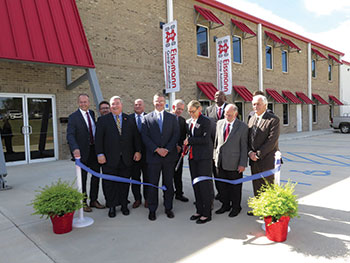 “With this expansion, Eissmann has become the largest employer in Pell City, and we are excited to see them continue to grow in our community. We are very fortunate that they chose our community as their North American headquarters, and we hope they will continue to expand here,” Pruitt said.
“With this expansion, Eissmann has become the largest employer in Pell City, and we are excited to see them continue to grow in our community. We are very fortunate that they chose our community as their North American headquarters, and we hope they will continue to expand here,” Pruitt said.











 When Blythe and family left North Carolina and headed west, he instructed his wife to tell no one that he had preached. No written record states exactly why he had become so disheartened; however, his friend and Alabama Baptist historian, Hossa Holcombe, hinted that the problem was a theological difference with North Carolina pastors concerning man’s free will.
When Blythe and family left North Carolina and headed west, he instructed his wife to tell no one that he had preached. No written record states exactly why he had become so disheartened; however, his friend and Alabama Baptist historian, Hossa Holcombe, hinted that the problem was a theological difference with North Carolina pastors concerning man’s free will. But being declared free and grasping the reality of freedom are two concepts not comprehended quickly. Former slaves, now free to congregate and worship together, continued to meet with Mt. Zion until 1868.
But being declared free and grasping the reality of freedom are two concepts not comprehended quickly. Former slaves, now free to congregate and worship together, continued to meet with Mt. Zion until 1868. Mrs. Long reminisced about the singing in the church. “They had people in the choir, and they sang the old-fashioned songs. Mattie Kelly was the pianist. She would play the piano, and they would sing. When she finished, she would always shout. She was one of the shouting sisters in church.” Another pianist was Mattie Jo Williams Herring.
Mrs. Long reminisced about the singing in the church. “They had people in the choir, and they sang the old-fashioned songs. Mattie Kelly was the pianist. She would play the piano, and they would sing. When she finished, she would always shout. She was one of the shouting sisters in church.” Another pianist was Mattie Jo Williams Herring.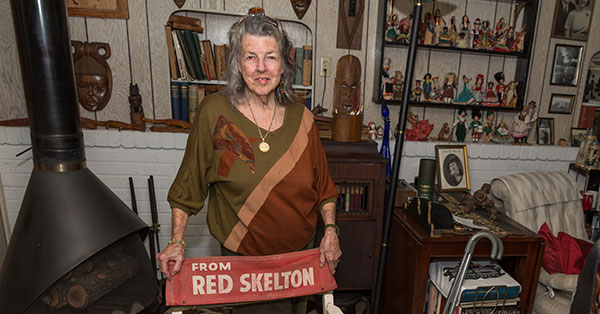
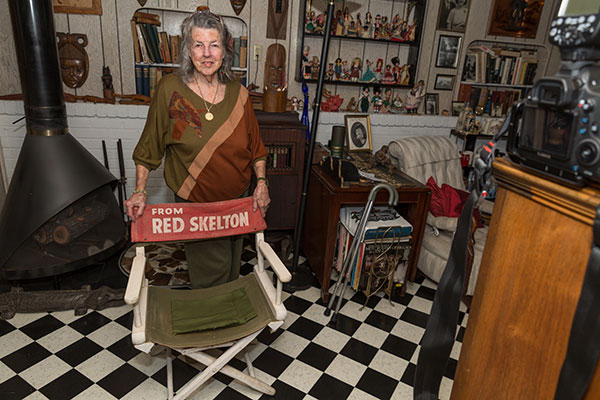
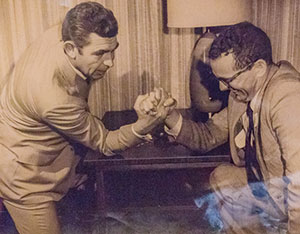 She would visit five continents; meet Rock Hudson, Clint Eastwood, Bob Hope, Lucille Ball and a legion of other stars; be part of a “Ben Casey” rehearsal; and lunch with Dustin Hoffman’s parents. She would even have to use her acting skills and an exaggerated Southern accent to talk her way out of trouble with President Richard Nixon’s Secret Service detail.
She would visit five continents; meet Rock Hudson, Clint Eastwood, Bob Hope, Lucille Ball and a legion of other stars; be part of a “Ben Casey” rehearsal; and lunch with Dustin Hoffman’s parents. She would even have to use her acting skills and an exaggerated Southern accent to talk her way out of trouble with President Richard Nixon’s Secret Service detail.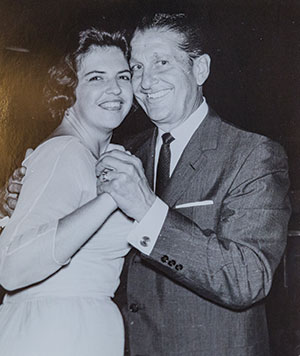 When Emmett completed his military service in 1953, he became entertainment editor at the Birmingham Post-Herald. Bobbye taught music at Saks Junior High School. The two also attended Birmingham-Southern College – Emmett to do his master’s coursework, and Bobbye to finish her degrees in English and Spanish.
When Emmett completed his military service in 1953, he became entertainment editor at the Birmingham Post-Herald. Bobbye taught music at Saks Junior High School. The two also attended Birmingham-Southern College – Emmett to do his master’s coursework, and Bobbye to finish her degrees in English and Spanish.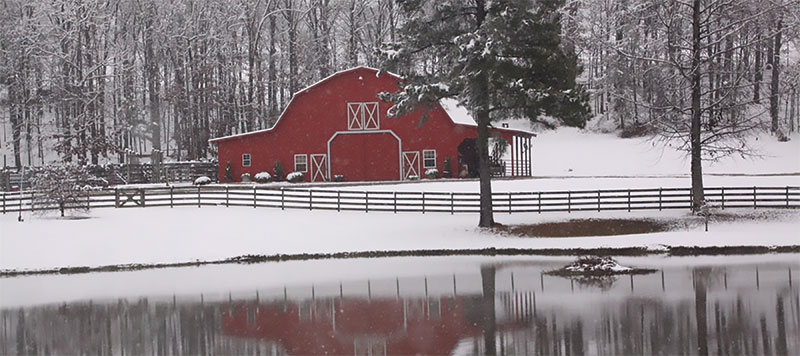
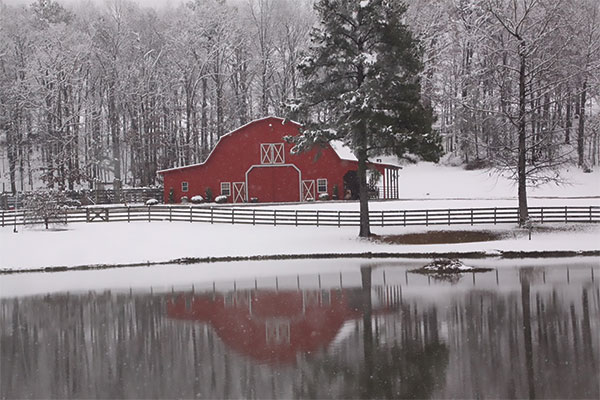
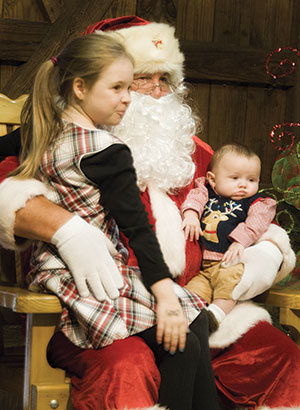 “A lot of children who don’t get to experience the things of the manger and all because they’re not involved in church, this is a way of being a witness to them that Christmas is not about Santa Claus, it’s about the birth of Jesus,” Mrs. St. John says. “You’d be surprised at how many children will start asking questions once I start telling the story of Jesus and how He was born in a stable and His bed was a trough that the cattle ate out of. They start asking questions and then you can start sharing about Jesus, and they’re so surprised. Then you have children who can tell you the story of Jesus, and it’s amazing how excited they get being able to tell you stuff about Jesus.”
“A lot of children who don’t get to experience the things of the manger and all because they’re not involved in church, this is a way of being a witness to them that Christmas is not about Santa Claus, it’s about the birth of Jesus,” Mrs. St. John says. “You’d be surprised at how many children will start asking questions once I start telling the story of Jesus and how He was born in a stable and His bed was a trough that the cattle ate out of. They start asking questions and then you can start sharing about Jesus, and they’re so surprised. Then you have children who can tell you the story of Jesus, and it’s amazing how excited they get being able to tell you stuff about Jesus.”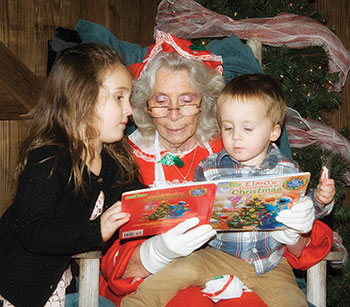 Some kids steer classic, pedal-powered metal toy tractors. Others run to Santa. Still others cuddle furry baby bunnies or pet pigs. Sometimes the barn is as quiet as a Christmas Eve mouse, but more often it’s a blizzard of activity. About 150 kids, with parents in tow, flocked to last year’s event.
Some kids steer classic, pedal-powered metal toy tractors. Others run to Santa. Still others cuddle furry baby bunnies or pet pigs. Sometimes the barn is as quiet as a Christmas Eve mouse, but more often it’s a blizzard of activity. About 150 kids, with parents in tow, flocked to last year’s event.

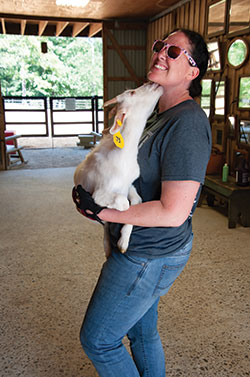 She found a company in Tennessee – Rent-A-Ruminant – that would bring a herd of goats to Alabama and let them do what goats do best. And on a warm, sunny day in August, kudzu started tumbling down like a row of dominos given a mighty thump.
She found a company in Tennessee – Rent-A-Ruminant – that would bring a herd of goats to Alabama and let them do what goats do best. And on a warm, sunny day in August, kudzu started tumbling down like a row of dominos given a mighty thump.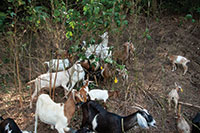 She decided when she returned home, she would buy a goat. And that she did. Her first was a Nigerian Dwarf, Becka, and you might say that goat cleared the path forward for her in more ways than one. After a second tour, this time in Afghanistan, she decided that when her Army career ended, her next career would involve goats. She had already started her farm and had moved to standard sized goats.
She decided when she returned home, she would buy a goat. And that she did. Her first was a Nigerian Dwarf, Becka, and you might say that goat cleared the path forward for her in more ways than one. After a second tour, this time in Afghanistan, she decided that when her Army career ended, her next career would involve goats. She had already started her farm and had moved to standard sized goats.
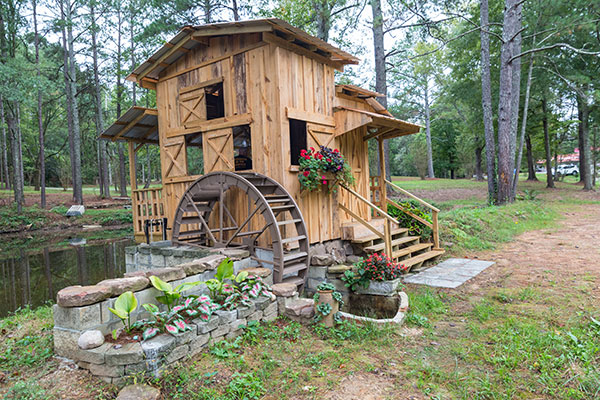
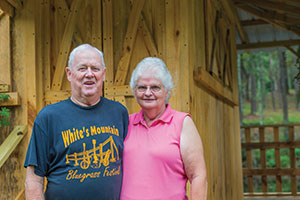 “We just love that kind of stuff,” Tommy said. “The old ways of doing things bring back memories of the old days, when people had to make it, grow it or do without it.”
“We just love that kind of stuff,” Tommy said. “The old ways of doing things bring back memories of the old days, when people had to make it, grow it or do without it.”